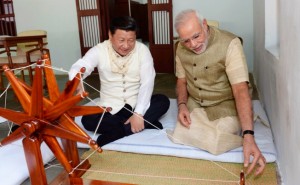 In September, Chinese President Xi Jinping made a three-day visit to India whereby he and Prime Minister Narendra Modi signed three pacts. Last month, Russian President Vladimir Putin paid a visit to PM Modi. U.S. Secretary of State, John Kerry, was just in India meeting with India’s 15th Prime Minister. During a meeting, the PM spoke about a ‘level playing field’ to make India a manufacturing hub, adding that government has put the focus on building infrastructure. President Obama will be in India towards the end of the month holding talks with top Indian leadership including Modi on various key bilateral issues. He will be the guest of honor at the Republic Day celebration. It’s clear, the world’s leadership is focused on Narendra Modi.
In September, Chinese President Xi Jinping made a three-day visit to India whereby he and Prime Minister Narendra Modi signed three pacts. Last month, Russian President Vladimir Putin paid a visit to PM Modi. U.S. Secretary of State, John Kerry, was just in India meeting with India’s 15th Prime Minister. During a meeting, the PM spoke about a ‘level playing field’ to make India a manufacturing hub, adding that government has put the focus on building infrastructure. President Obama will be in India towards the end of the month holding talks with top Indian leadership including Modi on various key bilateral issues. He will be the guest of honor at the Republic Day celebration. It’s clear, the world’s leadership is focused on Narendra Modi.
Last week I attended “India – Dealing with the New Regime.” This was the topic at the National Association of Corporate Directors lunch in Los Angeles. After a few challenging years for business under PM Manmohan Singh, Modi took office May 26, 2014 with high expectations that his appointment may result in greater ease in doing business in India. The program panel was comprised of three India experts. Santosh Anoo, Principal, Deloitte Consulting India; Anand Nallathambi, CEO, CoreLogic; and DJ Peterson, President, Longview Advisors. Hoshi Printer, NACD So Cal Programs Chair, moderated the panel.
Santosh started off saying that the change in Prime Minister is a shift less about governing, but a shift in philosophy. Economic development can and will help India. The BRIC countries, (Brazil, Russia, India and China) are seeing their economies slow. India is the only one that shows positive signs. Modi wants to see India as a manufacturing center, he thinks he can beat China in this. There are two top priorities that must first be met. Energy and infrastructure. Manufacturing cannot be built without both. A third area is the need to deliver talent. China has raised the level of education in the labor force. India has not. Santoosh says much of the labor force is not equipped. Education will be key. India has not done a good job fighting poverty. Infrastructure improvements have been promised for a long time. It is very difficult to get approval to build large scale projects, such as the Mumbai Subway. Taxation is problematic as each of the 29 states has their own system which inhibits inter-state commerce.
Anand talked about his business, Core Logic, and the challenges in reliability and credibility with businesses in India. Two million students are graduated each year with degrees in STEM (Science, Technology, Engineering and Math), yet they are not taught “how to go to work.” Many behaviors that could be put together under the title of workplace etiquette, are foreign concepts. So while the skills might be in place, the behavior is a block to success. And with those who have both the skills and etiquette, companies have to prove to them that they are a viable employer. And prove this to the prospective employee’s family. Companies have family days where families are invited in, given tours, overviews, to demonstrate that they are a “world class” company. The human capital issues are immense.
DJ talked about the key drivers that Prime Minister Modi has in his favor. A popular mandate for change, business is job #1, a long term pay and favorable external environment. He said that he will start out cautiously and then float some ideas to gauge public sentiment. He has elevated the role of economic reformers in his cabinet. Manufacturing is a way to put India’s ample and cheap labor to work. DJ is “optimistic” about India’s future.
All three made their presentations through the lens of what a corporate director should be thinking of when doing, or considering doing, business in India. While we are just past the sixth month mark of his term, Prime Minister Modi has big challenges ahead of him, but the prospects are bright.
http://southerncalifornia.nacdonline.org/Events/PastEvent.cfm?ItemNumber=12506
